The Marfan Syndrome Management Market is estimated to be valued at USD 1.3 billion in 2025 and is projected to reach USD 2.7 billion by 2035, registering a compound annual growth rate (CAGR) of 7.7% over the forecast period.
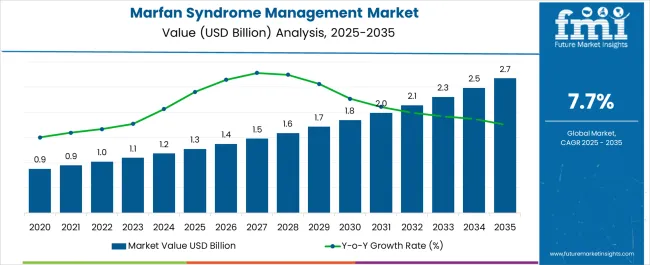
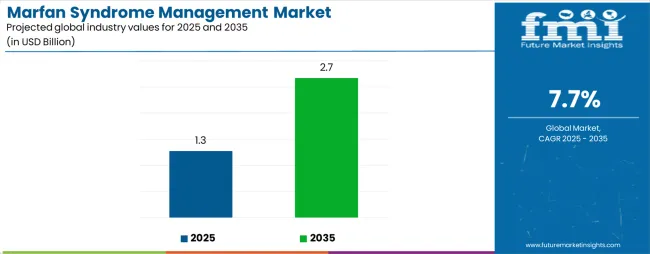
| Metric | Value |
|---|---|
| Marfan Syndrome Management Market Estimated Value in (2025 E) | USD 1.3 billion |
| Marfan Syndrome Management Market Forecast Value in (2035 F) | USD 2.7 billion |
| Forecast CAGR (2025 to 2035) | 7.7% |
The Marfan Syndrome Management market is expanding steadily, driven by the rising awareness of genetic disorders and increasing diagnosis rates of this rare connective tissue disease. Advancements in medical imaging, genetic testing, and personalized treatment approaches are improving patient outcomes and enabling early intervention. The market is benefiting from innovations in cardiac care, surgical procedures, and targeted therapies that address life-threatening complications associated with Marfan syndrome, particularly aortic aneurysms and heart valve issues.
Increased funding for rare disease research, alongside greater collaboration between healthcare providers and patient advocacy groups, is also strengthening growth prospects. Governments and private organizations are investing in infrastructure to enhance rare disease management, contributing to better availability of treatments and improved access to specialized care centers.
The demand for multidisciplinary management, involving cardiologists, geneticists, and ophthalmologists, highlights the importance of integrated care models As global healthcare systems continue to emphasize early detection and preventive management, the Marfan Syndrome Management market is poised to see consistent progress, supported by both technological advancements and increased patient-centric initiatives.
The marfan syndrome management market is segmented by treatment, distribution channel, and geographic regions. By treatment, marfan syndrome management market is divided into Heart Treatments, Aortic Dilation, Medicines, Beta Blocker, Calcium Channel Blocker, ACE Inhibitor, Surgery, Bone And Joint Treatments, Eye Treatments, Nervous System Treatments, and Lung Treatments. In terms of distribution channel, marfan syndrome management market is classified into Hospitals Pharmacies, Retail Pharmacies, and E Commerce Pharmacies. Regionally, the marfan syndrome management industry is classified into North America, Latin America, Western Europe, Eastern Europe, Balkan & Baltic Countries, Russia & Belarus, Central Asia, East Asia, South Asia & Pacific, and the Middle East & Africa.
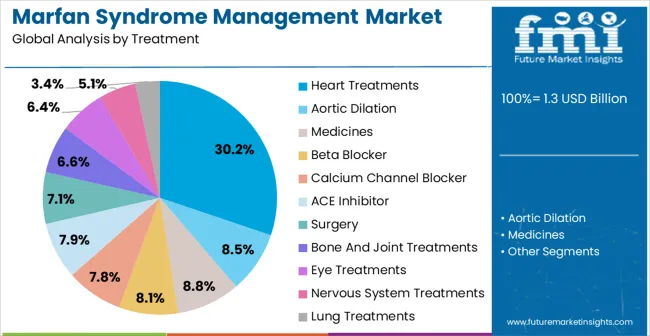
The heart treatments segment is projected to account for 30.2% of the Marfan Syndrome Management market revenue in 2025, positioning it as the leading treatment category. This dominance is being reinforced by the critical role of cardiovascular complications in Marfan syndrome, which remain the most significant cause of morbidity and mortality. Heart treatments encompass surgical procedures such as aortic root replacement, valve repair, and minimally invasive interventions, alongside pharmacological therapies like beta-blockers and angiotensin receptor blockers that help manage aortic dilation.
Advances in surgical techniques, coupled with improved perioperative care, are enhancing patient survival rates and outcomes. The rising availability of novel therapies aimed at reducing aortic complications is further accelerating growth in this segment.
Patients diagnosed early are increasingly being offered preventive treatments, which reduce risks associated with sudden cardiovascular events As healthcare systems prioritize specialized cardiac management for Marfan syndrome patients, the heart treatments segment is expected to maintain its leadership, supported by ongoing innovation in both surgical and pharmacological approaches.
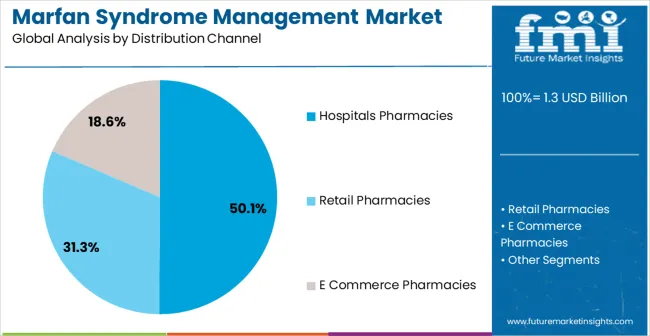
The hospitals pharmacies segment is anticipated to hold 50.1% of the Marfan Syndrome Management market revenue in 2025, making it the dominant distribution channel. This leadership is primarily being driven by the reliance of patients on hospital-based care for specialized treatments, surgical interventions, and comprehensive management programs. Hospitals pharmacies provide access to advanced therapies, specialized drugs, and immediate availability of treatment regimens, ensuring continuity of care.
The integration of pharmacies within hospital networks also facilitates efficient monitoring, prescription management, and follow-up, which are critical in managing chronic and rare conditions like Marfan syndrome. Additionally, the presence of expert healthcare professionals in hospitals strengthens trust and compliance among patients, leading to improved outcomes.
Hospital-based pharmacies often collaborate with multidisciplinary care teams, enhancing personalized treatment delivery and adherence to international guidelines As rare disease management becomes increasingly centralized in specialized healthcare institutions, hospitals pharmacies are expected to retain their leadership role, reinforced by their ability to provide holistic treatment options and immediate access to life-saving therapies.
Marfan Syndrome is a disease in which the connective tissue of the body is abnormal. Marfran syndrome affects the eyes, bones covering of the spinal cord, lungs and connective tissue of the heart and blood vessels. These connective tissue hold all the cells, tissues and organs together in the body. In addition it also plays roles in helping the body grow and develop.
Marfan syndrome is the genetic disorder that weakens and malfunctions the connective tissue. Connective tissue in the body is made up of protein, and the protein which plays the role in the marfan syndrome is fibrilin-1. Marfan syndrome is caused by the mutation in the genes which tells the body to make fibrilin-1. Marfan syndrome is hereditary which means it is inherited from the parent which indirectly affects the child.
The defected fibrilin protein cause the bones to grow longer than usual which means people suffering from the marfan syndrome have long legs and arms and are not normal. The marfan syndromes differ from person to person and diagnosis can be difficult.
Biggest threat of the marfan syndrome is that it damages the aorta, which carries blood from the heart to the rest of the body. Mafan syndrome ruptures the inner layer of the aorta which leads to bleeding. Surgery is required to replace the parts of the aorta which is being affected.
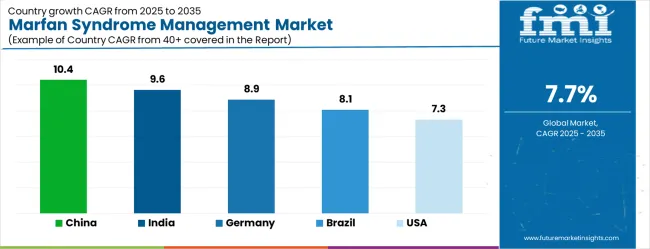
| Country | CAGR |
|---|---|
| China | 10.4% |
| India | 9.6% |
| Germany | 8.9% |
| Brazil | 8.1% |
| USA | 7.3% |
| UK | 6.6% |
| Japan | 5.8% |
The Marfan Syndrome Management Market is expected to register a CAGR of 7.7% during the forecast period, exhibiting varied country level momentum. China leads with the highest CAGR of 10.4%, followed by India at 9.6%. Developed markets such as Germany, France, and the UK continue to expand steadily, while the USA is likely to grow at consistent rates. Japan posts the lowest CAGR at 5.8%, yet still underscores a broadly positive trajectory for the global Marfan Syndrome Management Market. In 2024, Germany held a dominant revenue in the Western Europe market and is expected to grow with a CAGR of 8.9%.
The USA Marfan Syndrome Management Market is estimated to be valued at USD 464.2 million in 2025 and is anticipated to reach a valuation of USD 464.2 million by 2035. Sales are projected to rise at a CAGR of 0.0% over the forecast period between 2025 and 2035. While Japan and South Korea markets are estimated to be valued at USD 62.6 million and USD 32.7 million respectively in 2025.
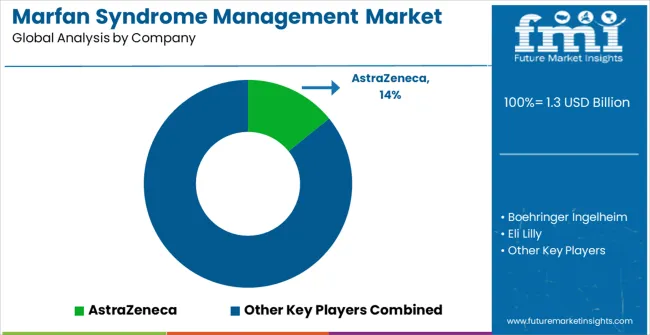
| Item | Value |
|---|---|
| Quantitative Units | USD 1.3 Billion |
| Treatment | Heart Treatments, Aortic Dilation, Medicines, Beta Blocker, Calcium Channel Blocker, ACE Inhibitor, Surgery, Bone And Joint Treatments, Eye Treatments, Nervous System Treatments, and Lung Treatments |
| Distribution Channel | Hospitals Pharmacies, Retail Pharmacies, and E Commerce Pharmacies |
| Regions Covered | North America, Europe, Asia-Pacific, Latin America, Middle East & Africa |
| Country Covered | United States, Canada, Germany, France, United Kingdom, China, Japan, India, Brazil, South Africa |
| Key Companies Profiled | AstraZeneca, Boehringer Ingelheim, Eli Lilly, AbbVie, Bayer, Pfizer, Takeda Pharmaceuticals, F. Hoffmann-La Roche, Amgen, Teva Pharmaceuticals, and Sanofi |
The global marfan syndrome management market is estimated to be valued at USD 1.3 billion in 2025.
The market size for the marfan syndrome management market is projected to reach USD 2.7 billion by 2035.
The marfan syndrome management market is expected to grow at a 7.7% CAGR between 2025 and 2035.
The key product types in marfan syndrome management market are heart treatments, aortic dilation, medicines, beta blocker, calcium channel blocker, ace inhibitor, surgery, bone and joint treatments, eye treatments, nervous system treatments and lung treatments.
In terms of distribution channel, hospitals pharmacies segment to command 50.1% share in the marfan syndrome management market in 2025.






Our Research Products

The "Full Research Suite" delivers actionable market intel, deep dives on markets or technologies, so clients act faster, cut risk, and unlock growth.

The Leaderboard benchmarks and ranks top vendors, classifying them as Established Leaders, Leading Challengers, or Disruptors & Challengers.

Locates where complements amplify value and substitutes erode it, forecasting net impact by horizon

We deliver granular, decision-grade intel: market sizing, 5-year forecasts, pricing, adoption, usage, revenue, and operational KPIs—plus competitor tracking, regulation, and value chains—across 60 countries broadly.

Spot the shifts before they hit your P&L. We track inflection points, adoption curves, pricing moves, and ecosystem plays to show where demand is heading, why it is changing, and what to do next across high-growth markets and disruptive tech

Real-time reads of user behavior. We track shifting priorities, perceptions of today’s and next-gen services, and provider experience, then pace how fast tech moves from trial to adoption, blending buyer, consumer, and channel inputs with social signals (#WhySwitch, #UX).

Partner with our analyst team to build a custom report designed around your business priorities. From analysing market trends to assessing competitors or crafting bespoke datasets, we tailor insights to your needs.
Supplier Intelligence
Discovery & Profiling
Capacity & Footprint
Performance & Risk
Compliance & Governance
Commercial Readiness
Who Supplies Whom
Scorecards & Shortlists
Playbooks & Docs
Category Intelligence
Definition & Scope
Demand & Use Cases
Cost Drivers
Market Structure
Supply Chain Map
Trade & Policy
Operating Norms
Deliverables
Buyer Intelligence
Account Basics
Spend & Scope
Procurement Model
Vendor Requirements
Terms & Policies
Entry Strategy
Pain Points & Triggers
Outputs
Pricing Analysis
Benchmarks
Trends
Should-Cost
Indexation
Landed Cost
Commercial Terms
Deliverables
Brand Analysis
Positioning & Value Prop
Share & Presence
Customer Evidence
Go-to-Market
Digital & Reputation
Compliance & Trust
KPIs & Gaps
Outputs
Full Research Suite comprises of:
Market outlook & trends analysis
Interviews & case studies
Strategic recommendations
Vendor profiles & capabilities analysis
5-year forecasts
8 regions and 60+ country-level data splits
Market segment data splits
12 months of continuous data updates
DELIVERED AS:
PDF EXCEL ONLINE
WHIM Syndrome Management Market Insights and Analysis for 2025 to 2035
Triple X Syndrome Management Market Size and Share Forecast Outlook 2025 to 2035
Carcinoid Syndrome Management Market
Central Pain Syndrome Management Market – Size, Share & Growth 2025 to 2035
Carcinoid Tumor Syndrome Management Market Forecast & Analysis for 2025 to 2035
Cytokine Release Syndrome Management Market - Trends & Future Outlook 2025 to 2035
Respiratory Distress Syndrome Management Market Size and Share Forecast Outlook 2025 to 2035
Tax Management Market Size and Share Forecast Outlook 2025 to 2035
Key Management as a Service Market
Cash Management Supplies Packaging Market Size and Share Forecast Outlook 2025 to 2035
Fuel Management Software Market Size and Share Forecast Outlook 2025 to 2035
Risk Management Market Size and Share Forecast Outlook 2025 to 2035
SBOM Management and Software Supply Chain Compliance Market Analysis - Size, Share, and Forecast Outlook 2025 to 2035
Case Management Software (CMS) Market Size and Share Forecast Outlook 2025 to 2035
Farm Management Software Market Size and Share Forecast Outlook 2025 to 2035
Lead Management Market Size and Share Forecast Outlook 2025 to 2035
Pain Management Devices Market Growth - Trends & Forecast 2025 to 2035
Data Management Platforms Market Analysis and Forecast 2025 to 2035, By Type, End User, and Region
Cash Management Services Market – Trends & Forecast 2025 to 2035
CAPA Management (Corrective Action / Preventive Action) Market

Thank you!
You will receive an email from our Business Development Manager. Please be sure to check your SPAM/JUNK folder too.
Chat With
MaRIA